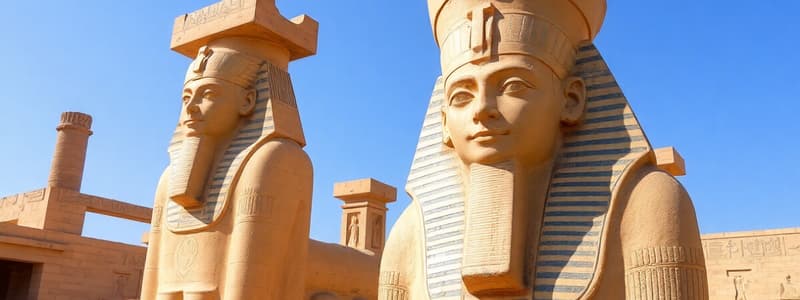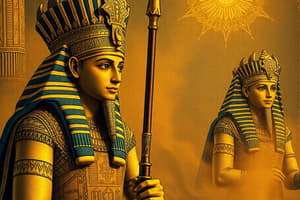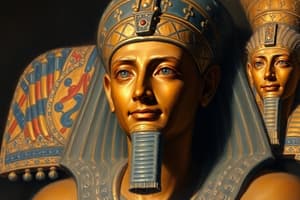Podcast
Questions and Answers
What does the discovery of ovens and grain storerooms at Tell Al-Abqain suggest about the fort's inhabitants?
What does the discovery of ovens and grain storerooms at Tell Al-Abqain suggest about the fort's inhabitants?
- They were largely self-sufficient in terms of food production and storage. (correct)
- They primarily consumed imported goods due to scarce local resources.
- They practiced a specialized form of agriculture focused on single-crop cultivation.
- They relied heavily on trade with neighboring communities for sustenance.
The presence of Ramses II's insignia on the sword suggests what about the sword's owner?
The presence of Ramses II's insignia on the sword suggests what about the sword's owner?
- The owner was a foreign diplomat visiting the Egyptian fort.
- The owner was likely a high-ranking military official or someone favored by the pharaoh. (correct)
- The owner was a common soldier randomly selected to carry the pharaoh's sword.
- The owner was a blacksmith responsible for the fort's weapon maintenance.
What inferences can be made from the discovery of bead necklaces and kohl applicators within the military fort?
What inferences can be made from the discovery of bead necklaces and kohl applicators within the military fort?
- The fort was used primarily as a trading post for luxury goods and cosmetics.
- The everyday lives of the soldiers included personal grooming and adornment practices. (correct)
- The soldiers of the fort were all conscripted from foreign lands.
- The fort only housed wealthy merchants and their families.
How does the discovery of the sword support Peter Brand's theory about the fort?
How does the discovery of the sword support Peter Brand's theory about the fort?
What was the primary purpose of kohl eyeliner in ancient Egypt, based on the archaeological discoveries at the fort?
What was the primary purpose of kohl eyeliner in ancient Egypt, based on the archaeological discoveries at the fort?
Considering Ramses II's expansionist policies, what strategic advantage did Tell Al-Abqain likely provide to ancient Egypt?
Considering Ramses II's expansionist policies, what strategic advantage did Tell Al-Abqain likely provide to ancient Egypt?
What does the presence of both limestone blocks, one engraved with the name 'Bay' and the other mentioning Ramses, suggest about the fort’s administrative structure?
What does the presence of both limestone blocks, one engraved with the name 'Bay' and the other mentioning Ramses, suggest about the fort’s administrative structure?
If the sword was indeed a gift, what symbolic role did it play in maintaining Ramses II's authority?
If the sword was indeed a gift, what symbolic role did it play in maintaining Ramses II's authority?
Flashcards
Ramses II's Sword
Ramses II's Sword
A bronze weapon discovered in Egypt, bearing Ramses II's insignia.
Tell Al-Abqain
Tell Al-Abqain
A 3,200-year-old military fort in northwest Egypt where the sword was found.
Peter Brand
Peter Brand
Historian who believes the sword suggests the fort was well-defended and had a weapons production area.
Sword Engravings
Sword Engravings
Signup and view all the flashcards
Kohl
Kohl
Signup and view all the flashcards
Ramses II
Ramses II
Signup and view all the flashcards
Ramses II's Reign
Ramses II's Reign
Signup and view all the flashcards
Fort Discoveries
Fort Discoveries
Signup and view all the flashcards
Study Notes
- A gleaming bronze sword was discovered by Egyptian archeologists on September 5, 2024.
- The sword bears the insignia of Ramses II.
- Ramses II was a powerful pharaoh of ancient Egypt.
- The sword has maintained its reflective shine despite being buried for over 3,000 years.
- The sword was located in a small room within one of the mud barracks of Tell Al-Abqain.
- Tell Al-Abqain is a 3,200-year-old military fort in northwest Egypt.
- The insignia suggests the sword belonged to a prominent military official.
- Historian Peter Brand believes the fort was well-defended and possibly had an on-site weapons production area.
- Brand theorizes the sword was likely a royal gift to a high-ranking officer.
- The king's name and titles on the sword served as a status symbol, enhancing the owner's prestige and advertising the king's wealth, power, and generosity.
Discoveries at the Ancient Fort
- Storerooms for grain and ovens for baking indicated a self-sufficient community once lived in the fort.
- Large clay pots contained bones of fish and other animals, suggesting a diverse diet.
- Bead necklaces and a kohl eyeliner applicator provided insights into the soldiers' personal lives.
- Kohl, a dark, black powder, was used by ancient Egyptians to shield their eyes from the sun.
- Two limestone blocks were found; one with the name "Bay" and the other mentioning Ramses.
Ramses II
- Often called Ramses the Great.
- He was the second longest-reigning pharaoh in ancient Egypt.
- He ruled for 66 years, from 1279 to 1213 BCE.
- He was the third king of the 19th Dynasty.
- Ramses II was known for his military skills and prowess.
- Egypt's borders expanded to modern-day Syria in the east and Sudan in the south under his rule.
- He was nicknamed the "builder pharaoh".
- Ramses II commissioned numerous temples and monuments.
Studying That Suits You
Use AI to generate personalized quizzes and flashcards to suit your learning preferences.





